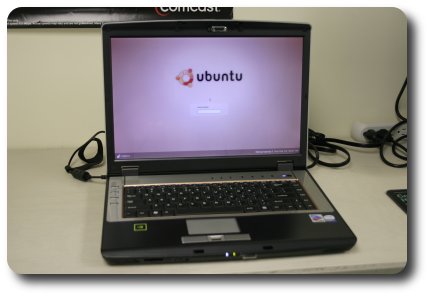Installing Ubuntu 6.10 'Edgy Eft' on a Jetta Jetbook 9700P
Some specifications (as tested):
|

|
More information (pdf) is available from Jetta.com
What doesn't work
I was not able to get the following components to work on this notebook:
modem: This notebook is equipped with a softmodem chip made by Agere (0x11c11040). I followed the instructions on linmodems.org for using the scanModem tool to try and get it working. It's close, in minicom I can send the modem ATZ and get back OK, but when I try to dial it immediately returns NO CARRIER. According to the guys on the linmodem.org mailing list, the problem is in the hda_intel.c file, and they're awaiting a fix from the ALSA experts.
What probably will work
I didn't have enough time to troubleshoot and/or experiment with these components to determine if they'd work or not. I'll post follow-ups as time becomes available.
built-in video camera: A video camera and microphone are built into the lid of this notebook. The microphone works find, but the video camera was not configured under any of the usual /dev/video devices. It does show up under the Device Manager, however, which leads me to believe it's possible to get it working.
Fingerprint sensor: This notebook is equipped with a fingerprint sensor located between the mouse buttons under the touchpad. There's some information on using a similar device on an IBM Thinkpad T42 located at JKraemer.net/linux which looks promising, but time did not permit me to experiment. I'll post a follow up when possible.
Some Fn buttons: Some of the blue Fn buttons don't do what they're supposed to, like the volume up/down.
IEEE 1394 FireWire: I don't have any 1394 devices to test this with, and I don't see it in the Device Manager either. It does show up in lspci -v, however. More information about this functionality is available on the Ubuntu Firewire Community page, and I'll post a follow-up when a device makes itself available to me.
Sleep/Hibernate Mode: The unit does go into sleep/hibernate mode when evoked, but the screen doesn't come on after it's been woken up. I did ssh into the unit to verify it was back up, but you have to reboot to get the screen back.
Hot Keys: Not all the hot keys do what they're supposed to, but they seem to be programmable so it's possible they can all be instructed to "do the right thing."
Summary of Installation
Ubuntu's Edgy Eft installed with no problems on this notebook. The screen automatically set up the resolution to 1280x800. The installation also recognized the wireless and ethernet (and modem, but it doesn't work - see above). This experience was much better than Fedora Core 6, which recognized only the ethernet on a virgin install. The default installation also placed a battery indicator in the gnome panel, which was cool.
After applying updates, the first thing I did was visit the Ubuntu Restricted Formats page for instructions on getting Mp3's and DVD's to play, as well as the other various codecs that don't come with a default Ubuntu installation. I tested the xine, totem, and vlc media players with The Dukes of Hazzard. All functionalities were working.
Then, I installed the network-manager-gnome package and its required dependencies and visited a good resource on the DebianAdmin.com page for instructions on enabling quick-and-easy wireless access.
The CD-RW worked great using either K3b or x-cd-roast. Inserting a blank CD opens an auto-popup with the choices, "Create Audio," "Create Data," or "Do Nothing." Clicking "Create Data" invokes CD/DVD Creator (I prefer K3b, so I did not test this), and clicking "Create Audio" opens Serpentine (again, I prefer K3b).
Two sound drivers were installed by default, the HDA Intel (ALSA) and Realtek ALC883 (OSS). I'm not sure if one is for the sound and the other meant for the modem, but only one device (/dev/dsp) was available when using audacity (using the ALSA driver), and it works fine with the built-in microphone.
Overall Impression
If you can live with a pcmcia modem that's known to work w/ Linux (like the 3Com 3CXM756), this notebook is a good choice. Almost everything is supported out-of-the-box with Ubuntu, and the wide screen is a nice touch. At around $1100, this is a good mid-range notebook to have.